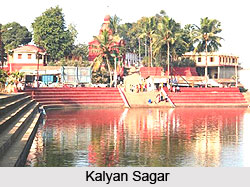 Kalyan Sagar is one of the sacred ponds of Agartala in Tripura. Agartala is the capital city of Tripura. Kalyan Sagar is often visited by the devotees of Agartala.
Kalyan Sagar is one of the sacred ponds of Agartala in Tripura. Agartala is the capital city of Tripura. Kalyan Sagar is often visited by the devotees of Agartala.
Location of Kalyan Sagar
Kalyan Sagar is a big lake which is located down the hillock at the back side of Mata Tripuraswari Temple. Located at eastern side of Mata Tripureswari Temple this is 3 kms away from Udaipur town.
Geography of Kalyan Sagar
This is a natural pond which has a large variety of aqua species. The pond covers an area of 2.752 acres which is full of fishes and tortoises. These fishes and tortoises are often worshiped by the devotees. Along with usual species the pond has some special variety of tortoises. Presently, the pond is being cemented by the committee of Mata Bari temple.
Extension of Kalyan Sagar
Kalyan Sagar is located on the eastern side of the Mata Tripuraswari Temple which is 3 km. away towards south from Udaipur town, Tripura. A big lake Kalyan Sagar just down to the Hillock at the backside of the Temple adds to its beauty. This natural pond has varieties of aqua species. The area of the Kalyan Sagar Lake is 2.752 acre.
Importance of Kalyan Sagar
Kalyan Sagar is considered sacred and devotees worship the fishes and tortoises present here. Kalyan Sagar is famous for very rare species of tortoise in large numbers. The Matabari Temple Committee is cementing the banks of Kalyan Sagar Lake for the last 2-3 years.
Pollution to Kalyan Sagar
Recently the pond has been polluted with acidic water due to destruction of ecosystem around the lake which has resulted into the death of the tortoises in the pond. Carrying of plastic poly bags are banned in and around Matarbari Temple area since 1998, even before the banning order issued by Tripura State Pollution Control Board (TSPCB) for the entire State of Tripura on 21st January 2002.
Tortoise in Kalyan Sargar
Kalyan Sagar is the natural habitat of the tortoise. A team of TSPCB consisting of Scientist and Engineer visited the lake and interacted with the local people on March 22, 2003. To check the water quality of the lake, TSPCB collected water samples from four locations of the lake and analyzed the different parameters of the water quality. The results of the study show that the water quality of Kalyan Sagar is very good and even drinkable. According to the experts, it is only the construction of the embankments that increased the mortality of the turtles.



















